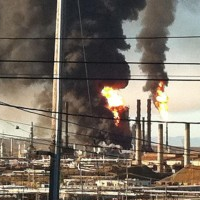Two Years after Richmond Fire, Feds Drop Proposal for Safety Overhaul
 Chevron refinery fire in Richmond (photo: Toni Hanna)
Chevron refinery fire in Richmond (photo: Toni Hanna)
Federal safety officials have been suggesting since the Richmond refinery fire in August 2012 that California overhaul its safety systems for industrial complexes.
The three-member U.S. Chemical Safety Board (CSB) entertained a plea last April that it recommend the state adopt the European “safety case” system, which emphasizes that regulation be based on setting goals with stated objectives, instead of having prescribed measures imposed with an ongoing inspection regime. They like it in the United Kingdom, Australia and Norway. Board Chairman Rafael Moure-Eraso wants it, and the staff strongly recommended it in a recently-released 115-page draft report.
Last week, the board rejected the idea, 2-1.
Instead, the staff was instructed to look at ways of strengthening existing regulations and inspection routines while continuing to research “safety case.” The board does not have any actual rule-making power, but its recommendations are taken seriously by state and local governments.
Although “safety case” is said to be a fan favorite among industries that want a more streamlined regulatory system, the chem board’s staff report did not garner the support of Chevron and other petroleum interests. Their public comments indicated a fear that the transition to a new system would be chaotic, costly and less safe.
Catherine Reheis-Boyd, president of the Western States Petroleum Association, warned of “complexity and confusion” by moving too quickly. But that is not an unfamiliar refrain from the industry on most any serious regulatory reform. Neither is her statement that, “Everyone in the petroleum refining industry is focused on safety.”
U.S. refineries reported 125 incidents involving chemical releases in 2012. A corroded pipe at the Richmond facility exploded in a fireball that year, engulfing the city in choking black smoke and potentially dangerous sulfuric acid and nitrogen dioxide fumes that sent 15,000 people to hospitals in the Bay Area.
The state handed Chevron 25 citations and fined the company $963,200 after the California Division of Occupational Safety and Health (Cal/OSHA) said the company had heard repeated warnings, many of them internally, about “pervasive violations.”
Twenty-three of the violations were considered “serious” by the state agency, including Chevron’s failure to institute emergency procedures to shut down the unit, the ordering of workers into the “hazardous incident zone” without proper equipment, and failing to recognize the “potential for catastrophic release of ignitable diesel fuel.”
The debate over “safety case” is probably not going away. But for now the focus will be on whether to strengthen the current regulatory process, described in Richmond’s lawsuit against Chevron as one of “neglect, lax oversight, and corporate indifference to necessary safety inspection and repairs that were known to have caused numerous other fires and explosions.”
–Ken Broder
To Learn More:
Chevron Fire Reforms Fall Flat with Federal Panel (by Jaxon Van Derbeken, San Francisco Chronicle)
Richmond: Federal Board Rejects Safety Recommendations Stemming from Chevron Refinery Fire (by Robert Rogers, Contra Costa Times)
U.S. Safety Board Members Clash over Regulatory Overhaul Proposal (by Erwin Seba, Reuters)
Chevron Richmond Refinery Pipe Rupture and Fire (U.S. Chemical Safety Board)
- Top Stories
- Controversies
- Where is the Money Going?
- California and the Nation
- Appointments and Resignations
- Unusual News
- Latest News
- California Forbids U.S. Immigration Agents from Pretending to be Police
- California Lawmakers Urged to Strip “Self-Dealing” Tax Board of Its Duties
- Big Oil’s Grip on California
- Santa Cruz Police See Homeland Security Betrayal in Use of Gang Roundup as Cover for Immigration Raid
- Oil Companies Face Deadline to Stop Polluting California Groundwater





